Those Charming Staffordshire Dogs
by
Bob Brooke
Staffordshire dogs have become one of the most
popular pieces of collectible ceramics in recent years. For those
interested in Victoriana, nothing quite exemplifies it as these
spaniels, originally created to be displayed on fireplace mantels during
the Victorian Era from the 1840s through the 1890s.
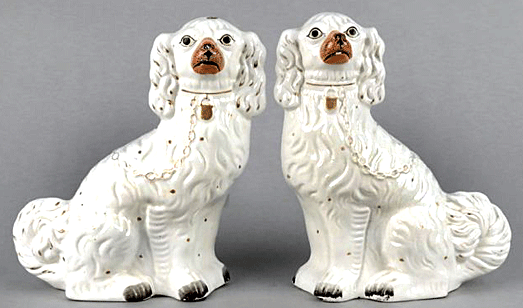
Origins
Staffordshire pottery dogs come from the many pottery companies located
in the County of Staffordshire, England, which produced them to sell to
working class families to decorate their homes. While they produced dog
figures from 1720 to1900, the peak of interest and, therefore,
production came towards the end of the 19th century. Staffordshire
spaniels are the most common and come in many sizes, shapes, and color
schemes.
The Staffordshire area, including Stoke-on-Trent, also known as "the
Potteries," has an abundance of local clay and coal. Local folk artists
used these resources to produce many charming unsophisticated figurines
to sell to the working class. Aside from dogs there were depictions of
other animals, royalty, famous persons, cottages, commoners,
politicians, and even murderers! Made to decorate fireplace mantels,
most had unfinished backs.
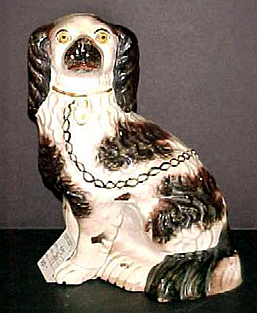 Also
called "pot dogs" or "china dogs," these were ceramic figures. Liquid
clay called "slip" was poured into molds to make them. When the clay
figure had dried, potters fired it to a hard "bisque" state. They then
covered the bisque figure with several coats of clear glaze then fired
it again, this time to a higher temperature. It was after this second
firing that they hand-painted them with china paint. This paint, being
translucent, had to be applied in several coats, with firings between
each coat. Finally, they applied real gold in a liquid suspension, with
firings between several coats. Also
called "pot dogs" or "china dogs," these were ceramic figures. Liquid
clay called "slip" was poured into molds to make them. When the clay
figure had dried, potters fired it to a hard "bisque" state. They then
covered the bisque figure with several coats of clear glaze then fired
it again, this time to a higher temperature. It was after this second
firing that they hand-painted them with china paint. This paint, being
translucent, had to be applied in several coats, with firings between
each coat. Finally, they applied real gold in a liquid suspension, with
firings between several coats.
Staffordshire spaniels are the quintessential Victorian decoration. Of
all the figures the potters created, sets of whimsical spaniels became
the favorite, and came to epitomize Staffordshire ceramics. Why do these
quaint dogs evoke the charm of the Victorian era so well? Perhaps, itís
because they offer collectors a direct connection to Queen Victoria.
The Inspiration
What dog inspired the figurines? Staffordshire potters modeled their
figures after dogs known as Cavalier King Charles Spaniels, named for
King Charles II of England who was constantly surrounded by these merry
little dogs and gave them free run at court. His opponents accused the
King of "Playing with his dogs all the while, and not minding his
business." Lord Rochester made this poetic observation, "His very dog at
Council Board, sits grave and wise as any Lord."
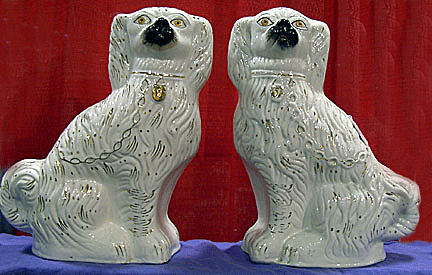 Charles's
brother and successor, James II, also loved the little spaniels. When
forced to abandon ship, he ordered "Save the dogs!" and after a moment
of reflection added, "and Colonel Churchill." Charles's
brother and successor, James II, also loved the little spaniels. When
forced to abandon ship, he ordered "Save the dogs!" and after a moment
of reflection added, "and Colonel Churchill."
Colonel Churchill later became the Duke of Marlborough, as well as a
breeder of the little spaniels. Churchill developed the strain of
Cavalier Spaniels that are white with chestnut patches called the
Blenheim. Blenheims sometimes have a much coveted chestnut spot on the
top of their heads. While Churchill was in Europe fighting the Battle of
Blenheim, his wife was at home nervously waiting to hear the outcome.
She found comfort by holding one of their spaniels that was soon to have
puppies. As she stroked the dog, her thumb was frequently pressed on
it's head. Her dog had five pups, each with a spot resembling a red
thumb print on the top of its head. The mark became known as the
Blenheim spot. Churchill won the battle of Blenheim and was rewarded
with a great house called Blenheim Palace.
It was Queen Victoria that brought the Cavalier King Charles Spaniel to
prominence. And it was her love for her own spaniels that attracted the
attention of Staffordshire potters in the mid-19th century. Her beloved
companion "Dash" became famous and the subject of many artists. On the
day of her coronation, she hurried back to Buckingham Palace to perform
an important duty. She gathered her skirts and ran up to her room to
give Dash his bath.
While many collectors think the potteries only produced spaniels, they,
in fact, produced other types of dogs, among them Dalmatians, the rarest
of all. Some potters mounted their Dalmatian figures on blue bases. They
also produced detailed poodles, as well as pugs, pointers, foxhounds,
sheepdogs, staghounds, setters, harriers and greyhounds. Staffordshire
dogs appear most commonly in left/right pairs, but sometimes potters
included a center figure. Over time the detailing changed and Victorian
potters in Staffordshire engaged in less detailed modeling of their
figures.
Buying Staffordshire Dogs
 When
purchasing Staffordshire dogs, collectors must first learn the
variations and what clue this may suggest about their age. Two similar
dogs can look quite different when side by side. Unfortunately,
collectors may not be able to look at them side by side. Itís important
to study these dogs in guides such as The Collector's Guide to
Staffordshire Pottery Figures, which shows such a side by side
comparison. When
purchasing Staffordshire dogs, collectors must first learn the
variations and what clue this may suggest about their age. Two similar
dogs can look quite different when side by side. Unfortunately,
collectors may not be able to look at them side by side. Itís important
to study these dogs in guides such as The Collector's Guide to
Staffordshire Pottery Figures, which shows such a side by side
comparison.
Staffordshire dogs dropped out of favor with collectors until the 1920s
and 1930s, when reproductions filled the market. As in Victorian days,
collectors displayed them on fireplace mantels. Even at that time,
prices were high. By the 1940s, collectors had lost interest and prices
plummeted. The dogs once again caught the attention of collectors in the
1980s and prices skyrocketed. Today, prices can be as low as $350 for a
pair of late 19th century spaniel figurines. However, rarer ones, like
Dalmatians, even when damaged or with known restorations, can sell for
several thousand dollars.
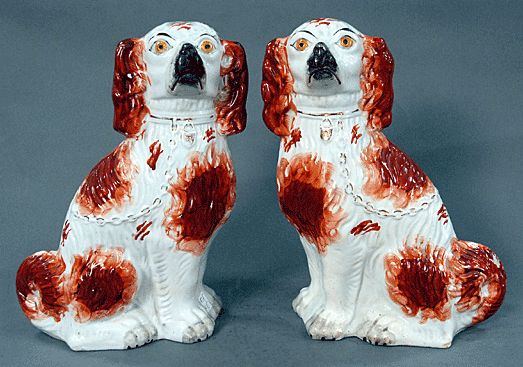
Since the early 19th century pieces are
the most expensive, itís important for collectors to recognize them when
they can be authenticated. Itís very important to become familiar with
the almost naive painting appearance, as well as the feel of the dogs.
Since artists painted hundreds of these figures by hand, no two of the
early ones look alike. Also, part of the charm of the early pieces may
also be because children, who did some of the painting, were among the
factory workers.
Determining Authenticity
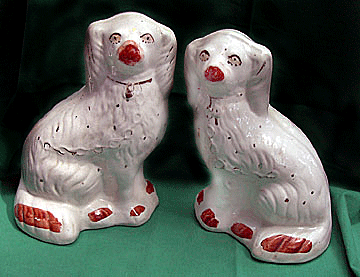 To
know if a piece is authentic or not, a collector should know that the
interior surface was smooth. Later figures, produced by the slip-casting
technique, have slight indentations. Collectors should also examine the
vent or firing holes. Current reproductions can have holes as large as a
quarter. Early, authentic figures have no holes. Since early molds still
exist, itís easy to reproduce the figures. To
know if a piece is authentic or not, a collector should know that the
interior surface was smooth. Later figures, produced by the slip-casting
technique, have slight indentations. Collectors should also examine the
vent or firing holes. Current reproductions can have holes as large as a
quarter. Early, authentic figures have no holes. Since early molds still
exist, itís easy to reproduce the figures.
Staffordshire potters never marked their figures. Other English
factories that did similar figures, such as Bow and Derby, did mark
their hand-molded pieces.
While most collectors may have one pair of Staffordshire dogs, itís only
when packed together does their beauty and their subtle differences
become apparent. A "pack" of Staffordshire dogs can form the theme for a
special room in a collectorís house. Of course, to do this most
collectors will either have to rob a bank or win the lottery.
To read
more of my articles, please
visit
my Web site.
<
Back to Antiques Articles
Next Article >
|
